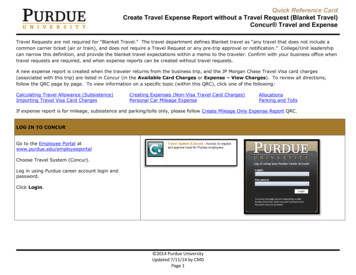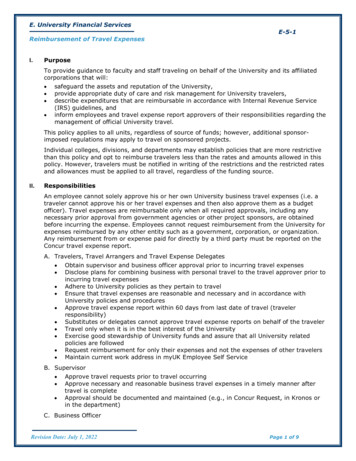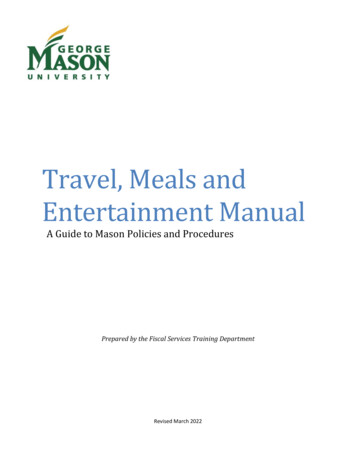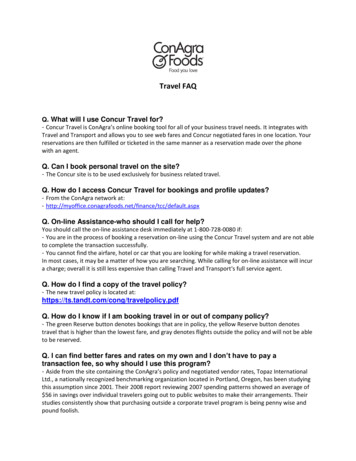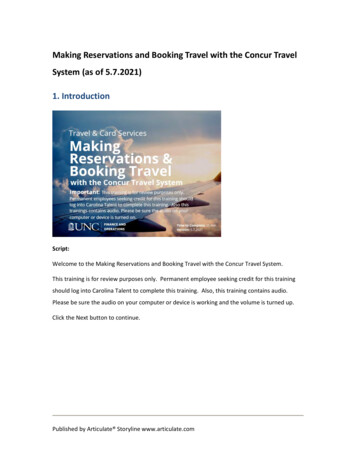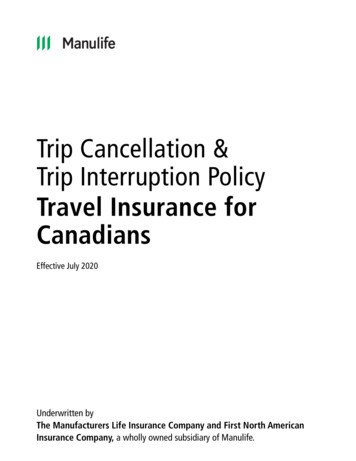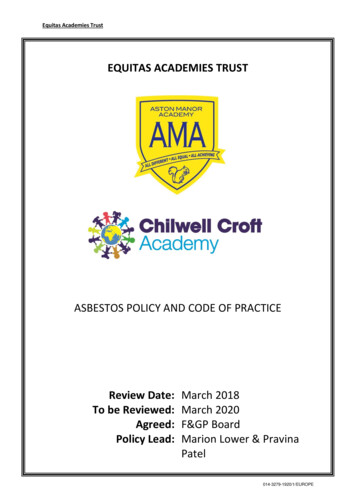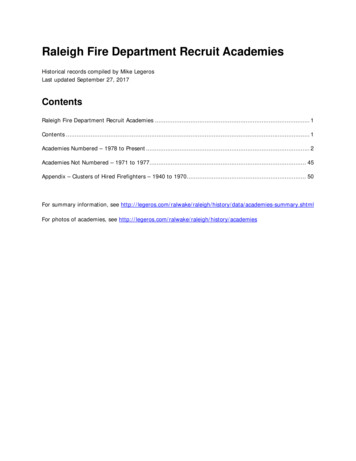
Transcription
TRANSPORTATION RESEARCH BOARDOF THE NATIONAL ACADEMIESTravelTrainingfor Older AdultsExecutiveSummaryby Jon E. BurkhardtExecutive Summary of TCRP Report 168Transit Cooperative Research ProgramTRANSPORTATION RESEARCH BOARD OF THE NATIONAL ACADEMIES1
THE PROMISE OF T RAVEL TRAININGMobility is essential for independent living.We need transportation to work, shop, get medical care, worship, enjoyeducational and recreational opportunities, or see friends and relatives.To reach these often geographically disperseddestinations, most of us drive a car or ride in someone else’s car.From time to time, even people who have regular and reliable use of a car will need other options to fulfill theirtransportation needs. By educating people about other options, travel training has the potential to maintain or improvethe mobility of older adults, people with disabilities, and others when they are not able to drive or have someone elsedrive for them.Travel training can help someone start using public transportation or other modes and use those modesmore effectively.While clearly not “the only answer” for the travel needs of all older people and all communities, traveltraining is a potent tool in the arsenal of strategies for improving or maintaining mobility for older adults.The Benefits of This Project2The Travel Training for Older Adults project providestools for making travel training more effective in meetingthe mobility needs of older people. Transit agencies andhuman services providers will find information about howto create, implement, sustain, and evaluate a travel trainingprogram for older adults so they can use fixed route publictransit services or other modes of travel.To make the best use of existing and future travel trainingprograms, transit operators and human services transportation providers need to understand which componentsof current travel training programs work best in whichsituations, which existing program components needmodification to be effective with older people, which newcomponents to add, who are the most likely target groupsfor such programs, and what are the best ways to conductoutreach to those target groups. This project’s Travel Training Handbook helps meet those needs by describing theseessential elements: The fundamentals of travel training programs, includingoutreach to the community and types of instruction andtheir component parts and content. The benefits of travel training realized in the near futureand potential longer-term benefits. Potential challenges to travel training programs, includingitems such as funding, staffing, and perceptions orconcerns of potential riders and their advocates.Executive Summary of TCRP Report 168TCRP Report 168: Travel Training for Older Adults,Part I: A Handbook is a manual for transportation, socialservice, aging, and training professionals that describes successful travel training practices and how to implement thesepractices in various community situations. The H andbookis intended as a resource for professionals who manage anddeliver travel training services and for anyone else interested in enhancing mobility options for older adults. The Handbook will be useful to transportation program staffwho work with seniors and people with disabilities, to peoplewho provide elder housing and operate senior centers, and toany others who work with older adults and want to supportindividual independence and mobility through safe and effective use of transportation alternatives. TCRP Report 168:Travel Training for Older Adults, Part II: ResearchReport and Case Studies describes how the findings forthis project were developed.This report builds upon both previous research and newresearch focusing on case studies of current travel trainingprograms for older adults. Twenty travel training programsacross the United States were selected for study because datawere available from various sources suggesting that theycould provide important information on how to create, sustain, and evaluate travel training programs for older adultsand that they would cooperate with this research effort.In-depth and on-site data were collected for seven traveltraining programs deemed to have highly developed andsuccessful programs. Information from another 13 sites wascollected with extensive interviews and follow-up activitiesbut without site visits.
Why Get Involvedwith Travel Training?Travel training for older adults creates substantial benefitsfor individuals and organizations, and these benefits aresignificantly larger than the costs. In fact, the list of benefits is long and extensive. Individual travelers can realizeincreased mobility and independence. Public transportationproviders, many of whom face severe resource constraints,can expect financial benefits. A large number of individualscould use travel training, and this number is expected togrow dramatically in the near future.The population of oldest adults (85 years of ageand older) in the United States will increasefrom about 5 million in 2011 (1.6 percent ofthe population) to about 18 million (4.5 percentof the population) in 2050. These projections suggest that concerns about the mobilityof older adults could be even greaterin the future.The benefits to the transit providers can also be quite substantial, as follows: There can be substantial cost savings to the transitagency or cost avoidance for the transit agency iftravel training can encourage paratransit riders to usefixed route services instead of the paratransit services. Travel training can benefit transit agencies by i ncreasingthe use of public transit and c ontributing to amobility options philosophy (providing people withmore options). Travel training programs typically create moreThe numerous benefits travel training provides for individual travelers include the following: Increased tripmaking, both short term and long term,leading to enhanced mobility and independence. Improved travel attributes, such as greaterflexibility with times of travel, no need to make advancereservations, and less dependence on family and friendsfor rides. Quality of life improvements, such as aging in place,getting out more often, reduced isolation, and freedomto travel spontaneously, according to individual needsor desires. Personal development, such as increased confidencein travel abilities and more control over one’s ownactivities and schedule. Economic benefits, such as lower costs for ridersand avoiding the costs of nursing homes.capacity on paratransit vehicles for riders who haveno other travel options than the paratransit services. Travel training generates good will among transit’sfunders with its emphasis on cost control and amongtransit’s consumers with its efforts to improvetheir mobility.Benefits like these are likely to have even more relevancein the future. Census Bureau projections indicate that thenumber of adults age 65 and older will grow from about40 million in 2011 (13 percent of the population) to about87 million in 2050 (about 21 percent of the population).Increases in life expectancy mean that this growth in theolder adult population will be even more dramatic for peopleage 85 and older. The population of oldest adults (85 years ofage and older) in the United States will increase from about5 million in 2011 (1.6 percent of the population) to about18 million (4.5 percent of the population) in 2050. Theseprojections suggest that concerns about the mobility of olderadults could be even greater in the future.Transit Cooperative Research Program3
What Are the Key Featuresof Successful Programs?Most programs, including travel training programs, canbe described by their components. A typical programdescription would include the following components: Program focus. Staff. Program Program operations.development. Partnershipdevelopment. Outreach. Monitoring and evaluation.From one perspective, all of these components are keys tosuccessful programs. Each of these categories represents animportant facet of travel training, but some elements standout as slightly more important than others. Based on information from the case studies and analyses by the researchteam, the following travel training program componentsdeserve greater attention: Hiring travel training staff based on personalqualifications (like compassion and understanding thevalue of travel training), social service experience, anddepth of experience. “People skills” are most important.4 Tailoring training to individual needs andFor older adults, age-related changes to vision or physical and cognitive skills can create concerns aboutfulfilling their transportation needs, but they still needto travel to lead vital and independent lives. As peopleage into older adulthood, they are more likely to experience health conditions that can make safe drivingmore difficult. Our society is oriented toward the use ofautomobiles by people of all ages, including older adults,for satisfying their mobility needs. Personal transportation is closely linked to the automobile due, in part, tosuburbanization, changing family structures, increasedvehicle affordability and availability, and a lack of alternative transportation options. Many older adults are notfamiliar with the benefits of traveling by public transportation or with the procedures and requirements forusing fixed route public transit services. Training olderpeople to use transit services has the potential to helpolder adults who cannot drive or choose not to drivemaintain mobility and quality of life.Executive Summary of TCRP Report 168capabilities. Focusing on customer service. Obtaining sustainable funding. Partnering with key community stakeholders. Continually monitoring and analyzing programimpacts. Fully documenting expenses. Following up overtime to document results and to offer more training ifneeded. Developing a performance measurement systemto evaluate program success. Documenting results inboth quantitative and qualitative terms with regularprogram reports. Integrating travel training into agency marketingand branding efforts; marketing the program througheducational outreach or through program partners.Effective travel training programs for older adults canbe complex to design and deliver, but they should besimple and understandable to older travel trainees.
Key components and activities of travel training will bestrengthened and enhanced by the following suggestions:Hire Professional, Well-Trained StaffThe travel training program should be staffed withprofessionals who understand a social service model ofprogram delivery and who understand the travel needsof older adults. Trainers must be able to connect withtrainees. Personal traits of trainers such as empathy,likability, respect, patience, and kindness are central tothis ability. The focus on customers as individuals is a keycomponent, and this includes attention to the feelings ofthe customers, which may include concepts of dignity andfears of losing independence. It is vital to understand eachperson, his or her unique skill sets and other resources,travel needs, and cultural background and needs. Trainercredibility is enhanced when the trainer regularly usesfixed route services. Trainers must be flexible, resilient,and calm, as they encounter unexpected changes in thereal-world training environment. A competent staff thatexcels in customer service is a key to program success.Emphasize Individual Abilities andLearning PatternsEffective travel training has a strong individual focus. Keysto effective travel training include keeping safety as theforemost concern; being sensitive to learning needs, styles,and patterns; involving the consumer in his or her owntravel training program; keeping the training steps shortand simple; taking cues from the trainee as to the speedand conditions of training; turning what may be negativeoccurrences in public transit travel into positive traveltraining learning experiences; being patient; keeping asense of humor; and making the learning process fun.Travel training curricula should be developed and organized toserve the diversity of travel training needs present among olderadults. Curricula need to encompass individual, group, andfollow-up or refresher training. In some circumstances, grouptraining may be sufficient, but some older adults are likely torequire individualized training, tailored to their capabilities,experience, environment, and the trip destinations they needto reach. Some trainees may require help in establishing newroutes or periodic re-training. Such training is essential for olderadults to continue to benefit from the use of fixed route or paratransit service, as services or personal capabilities may change.Focus on Customer Service and Customer BenefitsThe philosophy, vision, and mission of travel training programs should be designed to serve older adults, with savings in public transportation costs being a result, but not theprimary objective of the training program. A central elementshould be a social service model of service delivery, meaninga central focus on meeting the needs of older adults and theskills they require to remain active, mobile, independent, andable to age in place if that is their desire.Obtain Stable and Sustainable FundingA well-developed travel training program will incurexpenses for staffing, materials, facilities, and generaloperating support. Expenses should be tied closely to localneeds and resources; annual expenses can range from lessthan 50,000 for small programs to more than 800,000 forlarge programs with large numbers of trainees. Sustainablefunding is critical for maintaining continuing program viability. A strong travel training program will achieve savingsin paratransit service costs by increased use of fixed routeservice. Additional farebox revenues will accrue to publicTransit Cooperative Research Program5
t rainees typically measure benefits of training immediatelyupon completion of training and at 3-, 6-, 9- and 12-monthintervals; additional follow-up in later years is recommended.In addition, program results should report the costs ofproviding travel training services and the resulting transportation costs that are saved as a result of increased use of fixedroute transit services by older adults.Outcome measures should focus on measuring individualresults and overall program results. Measuring individual results shows the direct benefits to trainees. Programresults should measure aggregate benefits to older adulttrainees and measure the effectiveness of the programoverall, including cost savings for public transportationand other providers. Demonstrated cost savings are likelyto be critical to obtaining sustainable funding for the traveltraining program and to document individual results andoverall program results.Integrate Travel Training into CommunityOutreach and Education Efforts6transit systems from older adults who never used paratransitservice but who now ride fixed route service. Sustainabletravel training programs generate a financial benefit thatexceeds their cost; it is important to emphasize this result topotential funding partners.Create Strong Program Partners ThatInclude Public Transit SystemsThe organization that sponsors the travel training programwill find that program partners are essential to success. If thetravel training program is set up in an organization otherthan the local public transportation operator, the local publictransit system or systems should definitely be included as keypartners. Whether the travel training program operates insideor outside a public transit system, program partners shouldalso include human service agencies that provide services toolder adults, organizations that advocate for older adults, andsponsors of places where older adults gather. Strong partnerscan assist in encouraging volunteers who can help makesignificant reductions in a program’s costs.Monitor the Results of Travel TrainingMeasuring results is important for many reasons, includingdocumenting the benefits that older adults achieve. Benefitscan be measured in a number of ways. Surveys of travelExecutive Summary of TCRP Report 168Broad community support matters, from local governmentsthat serve and care about older adults in their communityto the general citizenry who take pride in their community.Outreach and education begin with program partners so theyfully understand the program, how it operates, and how olderadults and the community may benefit. Outreach is important to other community organizations that may help olderadults become aware of the travel training opportunities.Outreach also builds support within the business community.What Challenges Can TravelTraining Programs Face?When developing a travel training program, there may bechallenges to face or obstacles to overcome. Based on thecase studies conducted, the potential challenges of creating a successful travel training program might include the following issues:Maintaining consistent program funding streamscan be the biggest challenge travel training programs face.Funding for travel training is not ensured; a lack of stablefunding may limit the full potential of any travel trainingprogram. Funding issues can be complicated due to the variety of travel training operating models, differences betweenstates, and changes in the federal program structure. Staying
informed about new or changing sources of funding at all levels of government, but especially the federal level, is crucial. Travel training programs must understand how to createa scalable program that can adjust to the economy.At this time in 2014, federal funding for transportationprograms may face more serious limitations than before.This may make it harder for travel training programs to findappropriate funds. On the other hand, this may make traveltraining more attractive because of its potential to decreaserapidly escalating paratransit costs. Also, new federal transportation legislation (Moving Ahead for Progress in the 21stCentury Act, known as MAP-21) changes previous fundingpatterns for travel training. Operating successful programsin the face of these uncertainties will be a challenge.The nature of travel training programs may in itselfbe challenging. These programs involve equipping individuals to explore, use, and then thrive in environments thatthey may consider to be new, foreign, or even threatening.These perceptions can be overcome through training, butinitial perceptions may discourage some older adults fromeven entering a travel training program. Travel training programs may incur costs first, but some of the benefits, including cost savings, won’t accrue until months or even yearslater. On a personal level, many of the functional abilitylosses that can lead to older adults having to give up drivingcan also preclude them from using public transit even if it isavailable, meaning that there are some limitations on whocan benefit from travel training.Outreach is critical because bringing older adults intoa travel training program can be challenging for a numberof reasons: The frequently negative media culture surrounding theuse of public transit. For example, transit safety seems tobe reported as a much greater problem than it actually is.This negative reporting restricts interest in using publictransit, which can diminish participation in travel trainingprograms. Developing positive media outlets targeted toolder adults is critical. Difficulties in identifying a continuing stream oftrainees. Older people who need transportation do notnecessarily live in senior housing, and they might not beactive in senior center programs. The natural reluctance among some older adults Concerns for individual welfare. Some resistance hasbeen seen among older adults and often among theirfamily members regarding the physical challenges andpotential risks of riding public bus lines. Some older people may be reluctant to attend traveltraining programs at times when travel may be moredifficult, such as during periods of extreme cold or heat. Limitations in funding and staffing. These limitations mayconstrain the amount of outreach that is possible. The persistence needed to ensure that seniors, oncetrained, are traveling at stable or increasing rates.Collaboration is key to developing a successful traveltraining program. It takes time and resources to establishand nurture relationships between transit agencies andsenior living communities and the agencies that work witholder adults, but creating this collaborative working relationship will benefit the travel training program and thecommunity in the long run.Problems with the infrastructure of the publictransit system in the community (e.g., having busesavailable, having bus stops that are accessible, havingservices at the right times and to many destinations) maylimit who can benefit from travel training. Some communities will need coordination across political jurisdictions and among transit agencies, particularly in terms ofscheduling, route connections, and fare media. Obstaclesin the travel environment (broken sidewalks, no streetlights, and other problems) can be challenging for manypotential trainees.to ask for assistance while traveling.Transit Cooperative Research Program7
Improved TravelTraining PracticesAs a profession, travel training is relatively new. The vastmajority of its practitioners are highly dedicated, resourceful,hardworking, and sensitive to individual needs. With someof the basic procedures and practices now established, theindustry needs to focus its attention on better measuringits costs, benefits, and successes, and then transmittingthat information to its sponsors and other stakeholders.In particular, the following activities will be undertaken bythe most cost-effective travel training programs: Create and use common definitions of all trainingactivities and their results. Document all costs and benefits.Collect thesedata for each training component (such as one-on-onetraining and group training) and report that informationto program participants, family members and caregivers,funding partners, and the community. Analyze costs and benefits to improve programcost effectiveness.8 Implement processes to translate customer Enhance monitoring and follow-up activities.Follow training program graduates for more than oneyear to better assess the long-term impacts of training.Collect information on the differences that travel trainingmade in the lives of all of their participants, not just thosewho completed one-on-one training. The results can beused in funding justifications and accountability reportsto funders and service providers that refer clients tothe program. Use group orientations as a recruitment tool forfurther group and one-on-one training sessions. Obtain commitments from boards of directorsand management staff to the program’s visionand then to adequate funding for the trainingprogram. Detailed information about program costsand benefits will substantially enhance this effort. Convene a national program leadershipconference. The travel training industry wouldbenefit from opportunities for leaders of programs(as opposed to individual travel trainers) to interact,share lessons learned, and consider strategies to addressspecific challenges. The conference could focus onidentifying travel training program challenges and bestpractice solutions.feedback into program improvements. Find ways to make better use of volunteers. Broaden the depth and breadth of fundingcommitments. Use training program data to help transitproviders improve their services to older adultsand others.Strategies to accomplish these objectives might includethe following: Develop more precise statements of mission,goals, and objectives. Focus the goals and objectiveson reasonable expectations of outputs and outcomes oftraining activities. Adopt and apply industrywide standardsfor instructional activities for all traveltraining programs. Adopt and apply industrywide standardsof fully allocated cost accounting principlesand performance measures for all traveltraining programs.Executive Summary of TCRP Report 168SUMMARYMobility is essential because of the opportunitiesit unlocks. Travel training can improve mobility ofolder adults and lead to increased capabilities foractive, connected, independent, and vital lives.Copies of all products of this project are available in PDF format online athttp://www.tcrponline.org or http://www.trb.org by searching for TCRPReport 168.This work was sponsored by the Federal Transit Administration(FTA) and was prepared by Westat for the Transit CooperativeResearch Program, which is administered by the TransportationResearch Board of the National Academies. Jon E. Burkhardt wasthe Project Director and Principal Investigator for this research effort;other key authors included David J. Bernstein and Kathryn Kulbicki ofWestat, David W. Eby and Lisa J. Molnar of the University of Michigan Transportation Research Institute, Charles A. Nelson of NelsonDevelopment Ltd., and James J. McLary of McLary Management.Kristi O ’Donnell of Westat p rovided the graphics for this presentation.39702.0614.894301
Executive Summary of TCRP Report 168 For older adults, age-related changes to vision or phys-ical and cognitive skills can create concerns about fulfilling their transportation needs, but they still need to travel to lead vital and independent lives. As people age into older adulthood, they are more likely to expe-


